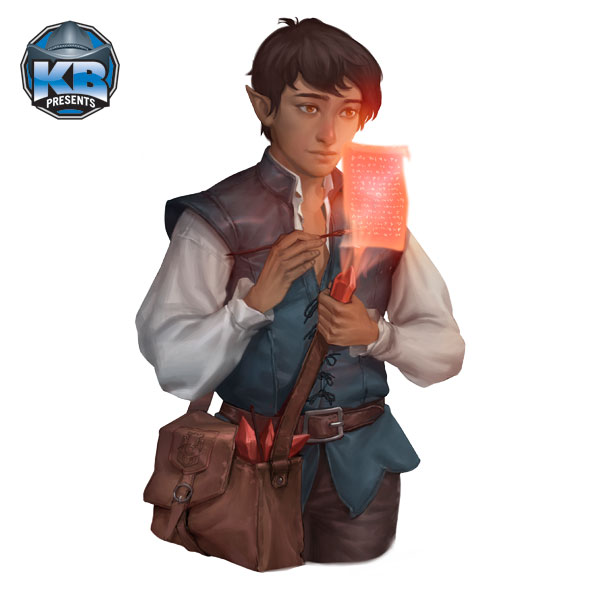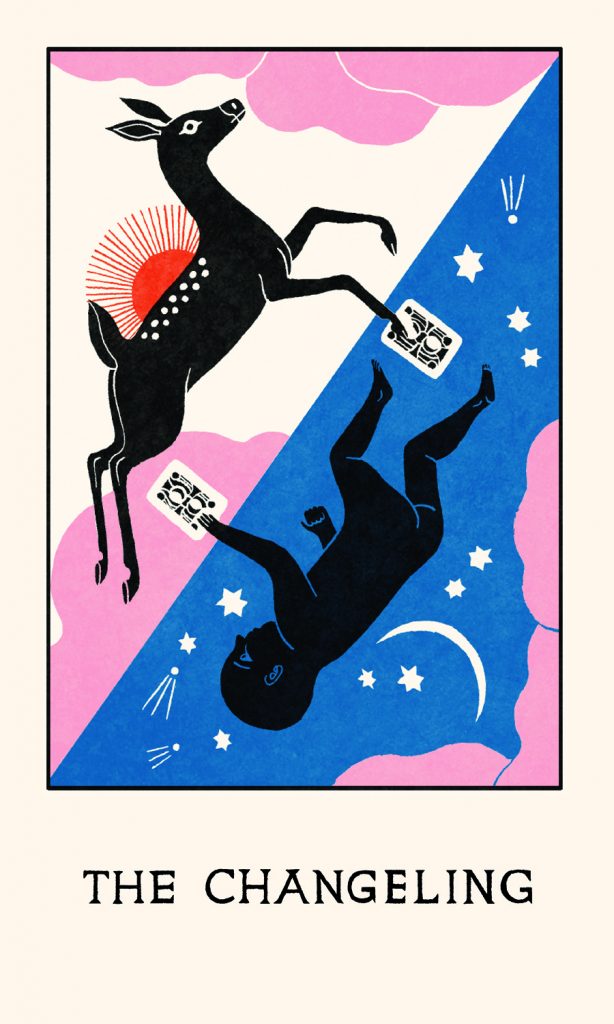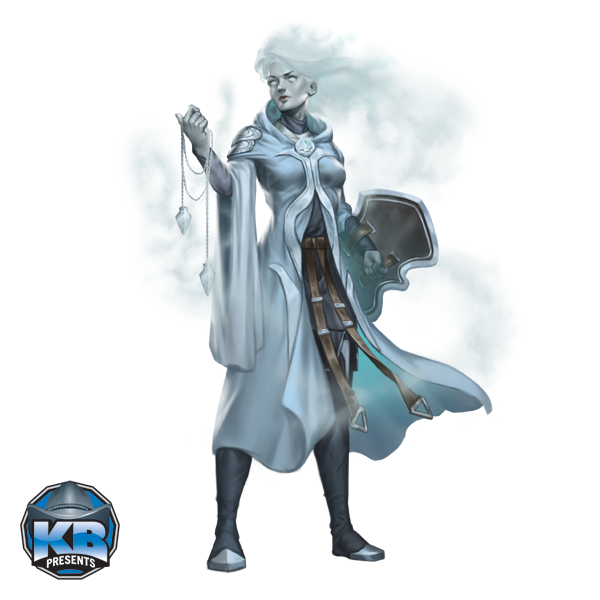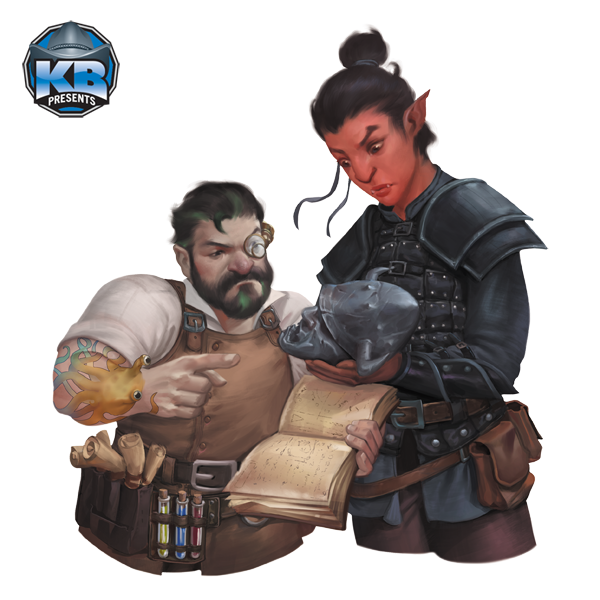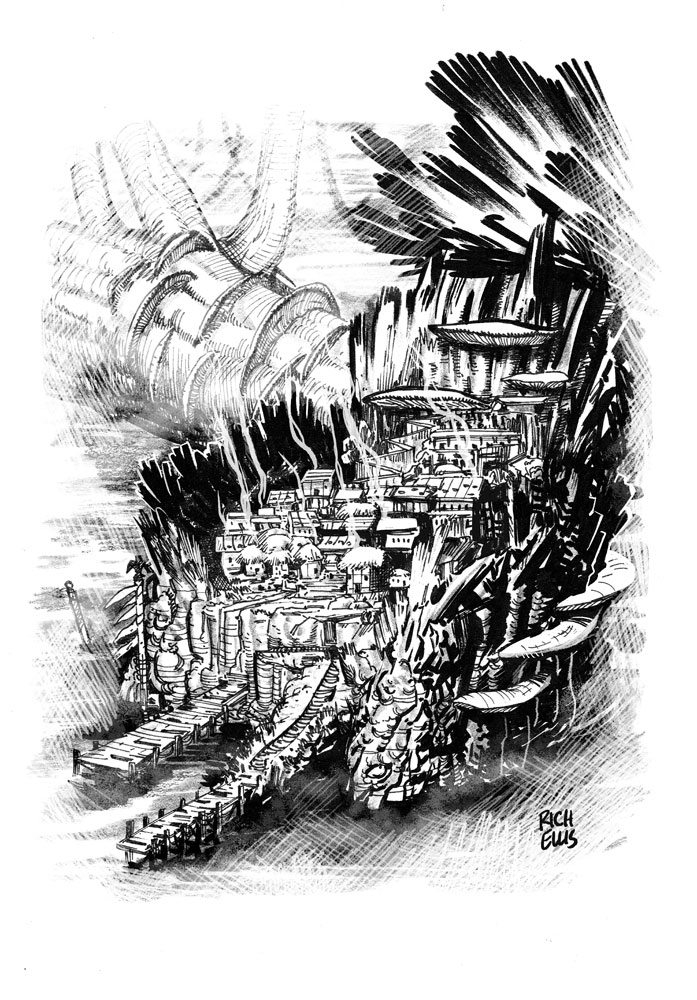
There’s no shortage of questions concerning the Eldeen Reaches, and I decided to answer a few more.
Does the Eldeen Reaches have a government and ministers? Is anything like the Code of Galifar enforced? Do the shifters in the Deep Wood acknowledge this? What’s the relationship between the Eldeen Reaches and other nations?
For the past forty years, the Eldeen Reaches have officially been under the protection and guidance of Oalian, the Great Druid of the Wardens of the Wood. Long dominant in the forest, the Wardens have spread out into the plains to ensure order throughout the region. Each village has a druid counselor who provides magical assistance and spiritual guidance, and who advises the leaders of the community. Councils made up of representatives from each farming family govern each of the communities. Bands of Warden rangers patrol the forest, responding to threats as they arise.
The shifter tribes and druid sects have their own customs, but leaders are usually chosen based on age and spiritual wisdom. Concepts of law are guided by the ways of nature, and justice is usually swift and harsh.
Politically, the folk of the Eldeen Reaches largely ignore the events of the east and are ignored in return. The Wardens of the Wood have made clear to Breland and Aundair that they will defend the nation against any military threat and have no interest in further discussions regarding borders, treaties, or resource rights.
Eberron Campaign Setting
These are the basic facts as laid out in the Eberron Campaign Setting. The Reacher communities are self-governing. Druidic advisors help guide the villages, and the Wardens of the Wood act as the connective tissue, “preserving order throughout the region”. Each community sets its own rules, inspired by the sect its aligned with. The Code of Galifar is a good general model; most things considered crimes in Sharn will probably be crimes in Varna. On the other hand, a village that’s embraced the teachings of the Children of Winter may have unusual ideas as to what constitutes a proper trial. The main point is that it’s very much what we’d consider frontier justice, with the Wardens acting as sheriffs and communities largely relying on the hue and cry–on people being ready to come together to help when a crime occurs. Meanwhile, the tribes of the Deep Wood generally respect Oalian and the Wardens, but only a few have chosen to become a full part of the Reacher experiment, and most still maintain the same traditions they’ve followed for centuries, ignoring the world beyond the Wood.
Politically “the folk of the Eldeen Reaches largely ignore the events of the east and are ignored in return.” Sharn: City of Towers specifically notes that the Eldeen Reaches don’t have any sort of consulate in Sharn and Five Nations says that they’ve rebuffed diplomatic contact with Aundair. But never forget that this is an experiment. The Treaty of Thronehold is only two years old; the Reaches are still figuring out what it means to be a nation, and how to play at politics. So at the moment, they don’t do much of it; they “largely ignore the events of the east” and “have no interest in further discussions.” But depending what happens in the days and years ahead the Reachers may realize that they have to forge stronger ties to other nations, and have to get better at the game of diplomacy. If adventurers have ties to the Reaches, they could be instrumental in helping to establish or protect the first Eldeen embassies.
What exactly IS the Towering Wood? What makes it different from any other forest?
The Towering Wood hasn’t been explored in depth in canon. Canon sources say that they are preternaturally fertile and that the forces of magic permeate the wood. We’ve mentioned greatpines and “awe-inspiring” bluewood trees. Reflecting my last post, the Eberron Campaign Setting has this to say…
The deep woods of the Eldeen Reaches remain mostly as uncultivated and pure as they were when the world was young. In the Age of Monsters, when the goblinoids forged an empire across Khorvaire, the Eldeen Reaches were the domain of orcs who sought to live in harmony with the wilderness. The orcs were devastated in the war against the daelkyr. As a result of this terrible conflict, the forest was seeded with aberrations and horrid creatures formed by the sinister shapers of flesh.
In my campaign the Towering Wood is surrounded by a buffer zone—a few miles of woodland where the trees are smaller, where there are certainly predators but where you aren’t as likely to piss off a dryad or encounter horrid wolves. The people of the fields have always hunted game and harvested lumber from this region, and it’s likely grown thinner over the history of Galifar. But the people have always known that there’s a line you don’t cross. Because when you reach the Wood itself… you feel that capital letter. You can feel its age and its power. And you if you blunder into it without knowing your way… Fey. Fiends. Aberrations. Plants twisted by Avassh. Undead. Horrid animals. Feral gnolls. Lycanthropes. Until a decade ago, Sora Maenya. If you just randomly chop down a tree, you might be cutting into Old Algatar, the great interconnected Eldeen Ada who will surely lay a terrible curse upon you or send a treant to crush you. And set aside all of these supernatural threats: if you just brought in a team to start cutting down bluewoods, you’d have to deal both with the Ashbound and the Wardens of the Wood; one of the prime directives of the Wardens is to protect the Wood from the outside world. It’s entirely possible Cannith has tried harvesting in the Towering Wood in the past; it’s just never ended well.
With that said, people live in the Towering Wood. The key is that you have to understand the threats, to be able to recognize warning signs, to know the locations of manifest zones and the safe paths maintained by the Wardens of the Wood. Looking to the present day, the Eldeen farmland communities work with their druidic advisors to harvest lumber from the edge of the Towering Wood, both ensuring that their actions are sustainable and that the lumberjacks don’t blunder into a dryad’s grove or one of Avassh’s bone orchards. Anyone can hunt and harvest from the Towering Wood… it just requires care and understanding.
But is the Wood actually like? For a start, it holds trees that don’t exist in our world. Greatpines are similar to the pine trees we know, but have thicker trunks and can reach heights of over 250 feet. The awe-inspiring bluewoods are more massive than our redwoods. But as you go deeper, you can encounter something different. This is a point where I break with canon—keeping the same general idea, but shifting it slightly. The ECS describes a specific region called The Guardian Trees, where the trees “dwarf the greatest redwoods”—but this is a very specific region that only spans about 30 miles. In my campaign, I take a different approach. First, I use the term guardian tree to refer to the Eldeen Ada. Second, in my Towering Woods those immense trees aren’t limited to a tiny region; they are spread across the forest. I call them titans—primordial trees that dwarf anything in our world, potentially thousands of feet in height. These titans are infused with primal energy—there’s the possibility they are literally the first trees, so they are sustained beyond what should be possible for any mundane fauna. The article I linked is tied to my Phoenix: Dawn Command setting, in which the titans have all fallen. In the Towering Wood I’d say most of the titans are still standing, but that there are a few that have fallen. This allows for the possibility of stumptowns (as pictured above, communities in the stumps of titans) or for communities or dungeons carved into the densewood trunks of fallen titans. Unlike the ECS, I spread these throughout the wood, but they are still rare; there’s a few dozen of them in total across the entire Wood. But each one is a truly remarkable landmark, and a wellspring of primal power. Traditional magic doesn’t work on a titan, so you can’t just animate one of them. Some people believe that the titans are awakened but are simply too vast to perceive humanoids; others believe that they hold the spirits of all the druids who’ve died in the region. Either could be true. To date Avassh hasn’t corrupted a living titan… but it could certainly have infested the trunk of a fallen one.
A final important point is that the map as it stands doesn’t show any rivers or bodies of water in the Towering Wood. This is solely because the maps have low resolution. Rivers and streams flow down from the mountains and through the wood, and there are pools tied to Lamannian and Thelanian manifest zones. There’s nothing on the scale of Lake Galifar or Silver Lake, but there are certainly immense ponds and streams that can prove challenging to cross.
What do the communities of the people in the Towering Wood look like?
The people of the woods hid from the eyes of Galifar, and most prefer the solitude of the Towering Wood to the bustle of the Five Nations. Shifters and centaurs sometimes live in their own isolated tribes, but the forest folk prefer to live in small mixed communities—human, elf, and shifter living side by side. They follow the faith of one of the druid sects, but only the most exceptional… join the patrols that guard woods and plains alike.
Player’s Guide to Eberron
There are many subcultures within the Towering Wood. Each of the druidic sects has its own tradition, and there are also sects that we haven’t discussed. The shifter Moonspeakers are a very significant faction that’s received little attention, primarily because they don’t interact much with the world beyond the Wood; there’s also a unique centaur tradition (though centaurs are also found among the Wardens, Greensingers, and other sects).
So first of all, you have the basic division of nomadic versus stationary communities. Within those categories, you see considerable variation reflecting the traditions of each sect and tribe. A detailed breakdown is beyond the scope of this article, but looking to the settled communities, some primarily create structures using tanned hides—essentially, tent cities, often extending up into the trees with hides stretched between strong boughs. Some build wooden platforms in the trees, while others—”root dwellers”—prefer sod walls and burrows going into the earth. In part, this depends on the weather and the nature of local threats, whether people need to take to the trees or if they feel secure on the ground. As noted below, people definitely take advantage of the resources the Wood presents; where you have a fallen titan (the tree, not the monster), people will build homes into the stump or the trunk. Beyond Greenheart, one of the largest communities in the Wood is just known as the Crossroads; this is a stumptown that lies along the migratory paths of a number of different nomadic tribes, which serves as central marketplace where people from different communities and sects exchange goods and services.
For the most part, however, the communities of the Wood are quite small. The Woodfolk don’t practice industrialized agriculture, so a community needs to be careful not to extend past the limits of local resources, and will split when it grows too far.
There’s a few things to keep in mind when dealing with the people of the Wood. Only the most gifted among them are full-fledged druids or rangers—just as few priests in the Five Nations are actual clerics, and few of the students in Arcanix are actually wizards. However, many possess some connection to primal power. This may be reflected by the abilities of a Gleaner, the primal equivalent to a magewright or adept. Gleaners can cast cantrips and perform spells as rituals, and as always their may have abilities beyond the standard spells; Deep Wood light-weavers create long-lasting light sources using a form of faerie fire. Gleaners also work with beasts in many ways, mirroring the ideas suggested for dinosaurs in this Talenta article; beasts serve as messengers, scouts, guards, beasts of burden, mounts, small-scale livestock, and more. Other Reachers master primal gifts that aren’t spells, and could possess gifts that mirror specific class abilities. Quite a few Deep Wood shifters master a limited form of wild shape allowing them to assume the form of a particular beast a few times a day (something that’s sure to send any follower of the Pure Flame crying “Werewolf!!!!”); even some non-shifters master this gift. A hunter might have a ranger’s Favored Foe feature, even if they don’t cast spells. Essentially, the full powers of a druid are remarkable—but primal magic and primal gifts are part of daily life in the Deep Woods. It’s also worth noting that on the whole, the people of the Deep Woods are highly competent, because they have to be. There’s a reason the Children of Winter lament how eastern civilization coddles the weak but have no such complaints about the people of the Wood, and a reason why the population of the Wood is far lower than that of the fields. The Towering Woods are dangerous. Survival is hard, and everyone is expected to contribute to their community. Ranger or not, every denizen of the Deep Wood has to be prepared to fight for survival. The tools may vary—some prefer a bow, some their own teeth, some a thorrn whip—but the Woodfolk are tough as ironwood, because they have to be.
Within a typical Woods community, everyone has tasks assigned to help the community, based on the skills they possess. The gleaners and actual druids of the community provide spiritual guidance, an expansion of the druidic advisors seen in the fields. Having said that, there ARE communities that are entirely comprised of initiates and hunters. Looking to the Wardens of the Wood, what you’ll see most are patrols, which function much like Valenar warbands: self-sufficient units capable of living off the land, which follow established paths between the major communities—helping travelers, containing new threats that have emerged, and maintaining ties between communities. You can also find circles, which function much like monasteries in the outside world; groups of gleaners and actual druids maintaining sacred sites and performing rituals, often for the benefit of nearby communities; for example, a circle may perform rituals which repel or calm horrid beasts in a wide area, or that hold back the influence of Avassh.
When creating a Deep Woods community, here’s a few things to consider.
- What sect are they associated with? Who’s their spiritual leader?
- What species are part of the community?
- Why have they chosen this location? Is there a manifest zone here, or an especially useful resource? In either case, how have they harnessed this?
- Do they work with a specific sort of beast?
- What are the most significant local threats? Does the community have a particular way of dealing with them?
If the Eldeen Reaches is so decentralized and lacks industry, how can it possibly challenge Aundair or any of the Five Nations?
There’s two key elements here. The first is the spirit and determination of the Reachers. It is unlikely that they could invade Aundair or Breland, but they have sworn to be independent and are willing to fight to the bitter end to maintain that independence. This ties to the point that the Wardens excel at small-unit guerilla tactics. Essentially, it’s a statement of you can try to invade us, but be warned that we will never surrender, that you will pay a price each and every day.
The second point is more enigmatic. While Thrane bends them a bit, in general the Five Nations play by the same set of rules. Go back a century and all their generals were trained at Rekkenmark. Their nations are grounded on arcane science and the services of the Dragonsmarked Houses. They know what to expect from one another. But the Eldeen Reaches don’t play by those rules. They’re a wide primal society, wielding a power that’s never been fully tested in this way. The Five Nations don’t know what the Reachers are capable of—and beyond that, the REACHERS don’t know what they’re capable of. The spells player characters wield provide us with a foundation, but Exploring Eberron already addresses arcane artillery and war rituals—the idea that the powers of a player character are oriented around swift squad combat. Given time, given tools, given a full circle of druids allied around the Great Druid themself—the Reachers wield the pure power of nature. They shattered the castles of tyrant lords with earthquakes and scattered armies with hurricanes. They terrified enemies with swarms of stinging insects and devastated them with plagues (“Those who survive will be stronger for it,” the Children of Winter say). The most infamous engagement was the battle for Varna, in which Lake Galifar itself rose up to fight for the Wardens. At least, that’s what the stories say. They’re surely exaggerated; but the point is that the druids were able to raise an elemental of unprecedented size and power that devastated Aundairian ships and sent their forces into disarray.
Even the Warden soldiers who were at the siege don’t know what was involved in raising Lake Galifar or if it could be done again. And that’s the point: the full capabilities of the Reaches are a mystery. Their army is a fraction of the size of any of the Five Nations. Their industrial capacity is far smaller. But no one—not even the Reachers themselves—knows what they are capable of. You can be sure that there’s teams in the Arcane Congress specifically devoted to analyzing and countering the primal capabilities of the Wardens. But for now, those mysterious powers are sufficient to give any nation pause.
Are there Treants in the Towering Wood?
Absolutely… both natural treants, fey treants, and the dreaded gaa’avash. In my campaign, the treants of the Towering Wood are the children of the Eldeen Ada. Each has its own distinct personality, but each treant is spiritually linked to one of the guardian trees and follows its direction. So Oalian doesn’t leave the Greenheart, but their child Gywahar was part of the Warden forces during the Secession and many of the enemy assumed the treant was Oalian themself. Meanwhile, fey treants are found in Thelanian manifest zones and essentially a variation of dryads—a different sort of tree story.
Avassh has great influence in the Towering Wood. Elsewhere there have been suggestions that the Barrens are barren because of some sort of massive defoliation effort enacted by the Dhakaani. Why wouldn’t the Towering Wood have suffered the same fate?
There’s no certain answer to this question in the present day; you’d need to consult ancient Dhakaani or the long-dead orcs of the Towering Wood. But there’s two obvious answers. The first is that Dhakaani lived in the region that’s now the Barrens, while they never lived in the Towering Wood. They had to do something because Avassh was destroying their people… while meanwhile, the orcs of the Towering Woods would never have supported such actions. Beyond this, I’d be inclined to say that whatever cataclysmic method they used likely wouldn’t have worked in the Towering Wood, which is “preternaturally fertile.” The primal power of the region made it a safer haven for Avassh, even if the titans themselves resisted her influence.
That’s all for now! As always, these answers are my opinions and may contradict canon sources. Thanks to my Patreon supporters for asking interesting questions and for making these articles possible; if you’d like to see more frequent articles or to be able to influence future topics, check it out!

